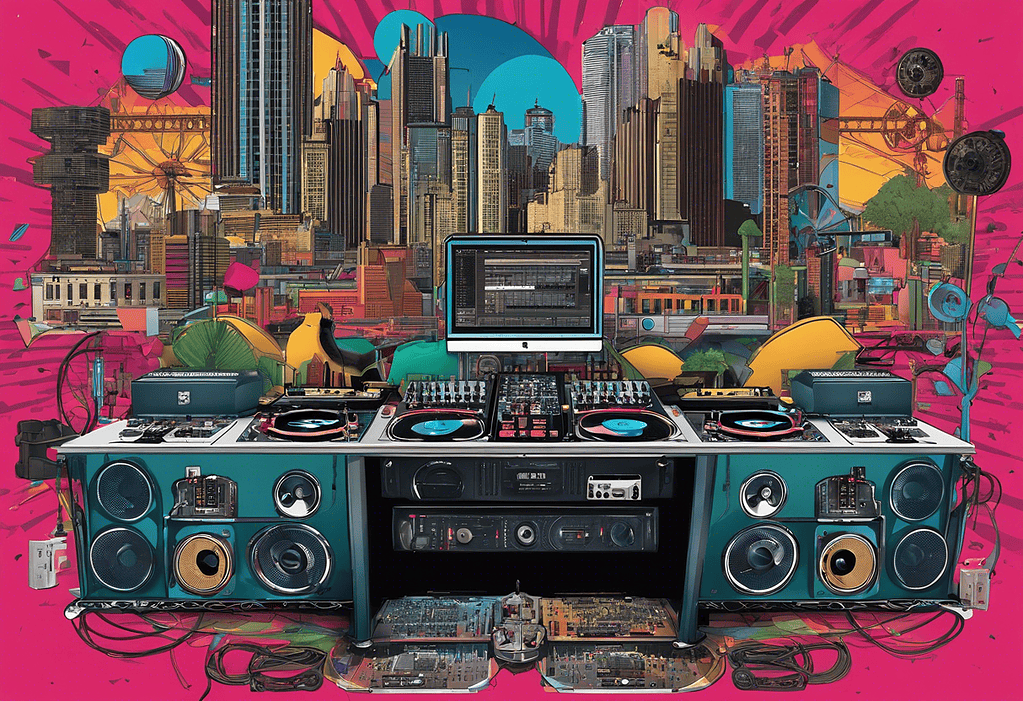a Comprehensive Guide to Techno Genres and Subgenres
Explore a comprehensive guide to techno genres and subgenres. Learn about the diverse world of techno music, including popular techno genres and subgenres.

Last Updated: December 21, 2024 (21.12.2024)
Introduction to Techno Music
Techno music, a groundbreaking genre of electronic dance music, has its roots in the vibrant city of Detroit, Michigan, emerging in the early 1980s. This genre is defined by its repetitive beats, synthesized sounds, and futuristic vibes. In this post, we will delve into the rich history of techno music, exploring its origins and key elements that make it distinct. We’ll discuss the pivotal role of pioneering artists like Juan Atkins, Derrick May, and Kevin Saunderson in shaping the genre.
Our exploration will cover the evolution of various techno subgenres, such as acid techno, dub techno, and minimal techno, each bringing unique characteristics and attracting diverse audiences. We’ll examine the impact of techno music on popular culture, highlighting its influence on fashion, art, and entertainment. Additionally, we’ll provide insights into the vibrant techno music festivals and events that draw enthusiasts from around the globe.
Furthermore, we’ll look ahead to the future of techno music, considering how technological advancements and global collaboration continue to drive innovation within the genre. Finally, for those new to the world of techno, we’ll offer tips for exploring the various subgenres and understanding the depth and breadth of this dynamic musical landscape. Join us as we journey through the pulsating beats and immersive soundscapes of techno music, uncovering its past, present, and future.
Key Elements of Techno Music
- Repetitive Beats: Techno music is known for its consistent beat pattern, usually around 120-150 beats per minute. This repetitive nature is a key element that drives the energy and rhythm of the music.
- Synthesized Sounds: Techno relies heavily on synthesized sounds and electronic instruments to create a futuristic and otherworldly atmosphere. These sounds are often manipulated and layered to create complex textures.
- Minimalism: Minimalistic elements are common in techno music, with tracks often featuring sparse arrangements focused on the interplay of a few key elements rather than elaborate melodies.
- DJ Culture: Techno music is closely tied to DJ culture, with DJs playing a significant role in creating and performing techno music. DJs mix and blend tracks seamlessly to create a continuous music flow on the dance floor.
History and Evolution of Techno Subgenres
Over the years, techno music has evolved, giving rise to various subgenres such as acid techno, dub techno, and minimal techno. These subgenres often explore different aspects of the genre, incorporating influences from other music styles and experimenting with new sounds and production techniques. Each subgenre has unique characteristics and appeals to various audiences within the techno music scene.
Techno music originated in Detroit, Michigan, in the early 1980s, blending electronic and funk music elements. Over the years, techno has evolved into a diverse range of subgenres, each with its own unique characteristics and influences.
- Detroit Techno: Considered the birthplace of techno, Detroit techno emerged in the mid-1980s, with artists like Juan Atkins, Derrick May, and Kevin Saunderson pioneering the genre. Characterized by its futuristic sound and minimalistic approach, Detroit techno laid the foundation for the genre as a whole.
- Berlin Techno: In the early 1990s, Berlin became a hub for techno music, influencing a new wave of artists and sound. Known for its dark, industrial beats and pulsating rhythms, Berlin’s techno has become synonymous with the city’s vibrant club scene.
- Minimal Techno: Minimal techno emerged in the late 1990s, focusing on stripped-down, repetitive rhythms and a simplistic approach to production. Artists like Richie Hawtin and Ricardo Villalobos are known for their contributions to this subgenre, emphasizing the “less is more” philosophy.
- Tech House: Combining techno and house music elements, tech house blends the driving beats of techno with the soulful melodies of house. Popular in clubs and festivals, tech house has a broad appeal and is known for its energetic vibe on the dance floor.
- Electro Techno: Drawing influence from electro and techno, this subgenre features robotic sounds, distorted basslines, and intricate melodies. Artists like Dopplereffekt and Gesaffelstein are known for their contributions to electro techno, pushing boundaries and exploring new sonic territories.
Techno genres continue to evolve and hybridize, reflecting the ever-changing landscape of electronic music. From the underground clubs of Detroit to the warehouses of Berlin, techno music remains a powerful force in the global dance music scene.

Understanding Mainstream Techno Subgenres
Techno music has evolved over the years, giving rise to various subgenres that cater to different tastes and preferences within the electronic music scene. Understanding the mainstream techno subgenres can help enthusiasts navigate the vast world of techno with more clarity and appreciation. Here are some key mainstream techno subgenres to explore:
- Detroit Techno: Originating in Detroit in the 1980s, this subgenre is characterized by its soulful melodies, intricate rhythms, and futuristic soundscapes. Artists like Juan Atkins, Derrick May, and Kevin Saunderson are considered pioneers of Detroit techno.
- Minimal Techno: Known for its stripped-down, minimalist approach, minimal techno focuses on simple yet hypnotic rhythms and textures. Artists such as Richie Hawtin and Ricardo Villalobos have significantly contributed to this subgenre.
- Tech House: Combining elements of house and techno, tech house features groovy basslines, infectious beats, and a more upbeat feel. This subgenre is popular in clubs and festivals worldwide, with artists like Carl Cox and Green Velvet leading the way.
- Industrial Techno: With its raw, dark, and aggressive sound, industrial techno draws influence from industrial and EBM music. Artists like Adam X and Ancient Methods are known for pushing boundaries within this subgenre.
- Melodic Techno: Focusing on emotional melodies, harmonies, and atmospheric soundscapes, melodic techno offers a more nuanced and introspective take on techno music. Tale of Us and Stephan Bodzin are renowned for their contributions to this subgenre.
Exploring these mainstream techno subgenres can enrich one’s understanding of the diverse styles and sounds within the techno genre, providing a deeper appreciation for the creativity and innovation that continues to shape the electronic music landscape.
Exploring Underground Techno Subgenres
In the vast landscape of techno music, numerous underground subgenres exist that cater to niche audiences and push the boundaries of traditional techno sounds. These subgenres often blend various elements of electronic music, resulting in unique and experimental sonic experiences. Here are some of the most intriguing underground techno subgenres to explore:
- Industrial Techno: Characterized by abrasive and harsh sounds, industrial techno takes inspiration from industrial and post-industrial music. It often features distorted beats, metallic textures, and dystopian atmospheres, creating a raw and aggressive listening experience.
- Dub-Techno: A fusion of techno rhythms and dub reggae influences, dub-techno is known for its deep and atmospheric soundscapes. Characterized by reverb-drenched chords, offbeat delays, and an emphasis on space and texture, dub-techno offers a mesmerizing and hypnotic journey for listeners.
- Minimal Techno: Emphasizing stripped-down rhythms, minimal techno focuses on repetitive patterns and subtle variations. With a minimalist approach to production, this subgenre employs sparse arrangements and sparse textures to create a hypnotic and immersive listening experience.
- Detroit Techno: Originating from the city of Detroit in the 1980s, Detroit techno is characterized by its soulful melodies, driving rhythms, and futuristic sound palette. Influenced by the electronic sound of Kraftwerk and the funk of Motown, Detroit techno has played a significant role in shaping the techno genre as a whole.
- Acid Techno: Known for its distinctive use of the Roland TB-303 synthesizer, acid techno features squelching, resonant basslines, and psychedelic textures. Originating from the underground rave scene of the 1980s, acid techno continues to evolve and inspire new generations of techno producers.
Exploring these underground techno subgenres can offer a deep dive into the diverse and innovative world of electronic music, providing a rich tapestry of sounds, rhythms, and atmospheres for adventurous listeners to discover and enjoy.

Key Characteristics of Techno Subgenres
Minimal Techno
Minimal techno emerged in the early 1990s, emphasizing simplicity and repetition. The genre focuses on stripped-down rhythms, often utilizing a limited number of instruments and effects to create an intense, immersive atmosphere. This minimalist approach aims to highlight the purity of the sound, creating a hypnotic and deep listening experience. The tracks are characterized by their subtle progression and meticulous attention to detail.
Notable Artists
- Richie Hawtin: A pioneering figure in minimal techno, known for his innovative use of technology and live performances. His work under the alias Plastikman is particularly influential.
- Robert Hood: One of the founding members of the Detroit techno collective Underground Resistance, Hood’s minimalist approach has been pivotal in shaping the genre.
Detroit Techno
Detroit techno originated in the mid-1980s in Detroit, Michigan. It combines elements of funk, electro, and Chicago house music and is characterized by its soulful melodies, complex rhythms, and futuristic themes. The genre often explores themes of technology and utopianism, reflecting Detroit’s industrial landscape. It is known for its rich, emotive soundscapes and driving beats.
Notable Artists
- Juan Atkins: Often referred to as the “Godfather of Techno“, Atkins’ work with Cybotron and Model 500 laid the foundation for Detroit techno.
- Derrick May: His tracks, such as “Strings of Life” under the alias Rhythim Is Rhythim, are considered classics of the genre, known for their emotional depth and musical complexity.
- Kevin Saunderson: As a member of the Belleville Three alongside Atkins and May, Saunderson’s work helped define the sound of Detroit techno. His Inner City project achieved mainstream success with hits like “Good Life” and “Big Fun“.
Dub Techno
Dub techno is a subgenre that combines the deep, reverberant sounds of dub music with the repetitive structures of techno. It emerged in the early 1990s and is characterized by its use of deep basslines, echo, reverb, and delay effects. The result is a hypnotic, atmospheric sound that emphasizes texture and space, creating a meditative listening experience.
Notable Artists
- Basic Channel: The duo of Moritz Von Oswald and Mark Ernestus, whose releases in the early 1990s laid the groundwork for the dub techno genre. Their minimalist approach and heavy use of reverb and delay effects are iconic.
- DeepChord: The project of Rod Modell, known for its lush, ambient textures and deep, immersive soundscapes that define the essence of dub techno.
Acid Techno
Acid techno emerged in the late 1980s. It is distinguished by its use of the Roland TB-303 bass synthesizer, which produces the distinctive “acid” sound. This subgenre is characterized by its squelching, resonant basslines and energetic, driving beats. Acid techno is known for its raw, intense energy and is often associated with the rave and underground party scenes.
Notable Artists
- Hardfloor: The German duo known for their complex and mesmerizing acid lines, particularly their track “Acperience 1“, which is considered a classic in the genre.
- Josh Wink: An influential figure in acid techno and house, his track “Higher State of Consciousness” is a seminal example of the acid sound.
- Chris Liberator: A key figure in the London acid techno scene, known for his hard-hitting tracks and contributions to the underground rave culture.
Industrial Techno
Industrial techno merges the harsh, abrasive sounds of industrial music with the rhythmic structures of techno. This subgenre features distorted sounds, metallic percussion, and dark, brooding atmospheres. It often evokes a sense of dystopia and intensity, creating a visceral and immersive experience.
Notable Artists
- Surgeon: A leading figure in industrial techno, known for his relentless, powerful tracks and innovative approach to production.
- Regis: Co-founder of the influential label Downwards, Regis’ music is characterized by its raw, minimalistic approach and industrial aesthetics.
- Ancient Methods: Known for their “pitch black techno war funk“, Ancient Methods combine industrial, techno, and experimental sounds to create a unique, intense listening experience.
Tech House
Tech house is a fusion of techno and house music, combining the melodic and groove-oriented elements of house with the rhythmic and mechanical aspects of techno. The genre emphasizes a steady, danceable beat with intricate percussion and subtle, melodic progressions. Tech house is known for its versatility and broad appeal on dance floors.
Notable Artists
- Carl Cox: A legendary DJ and producer, Carl Cox is known for his dynamic and energetic sets that seamlessly blend techno and house.
- Joris Voorn: A Dutch DJ and producer whose melodic and groove-centric tracks have made him a key figure in the tech house scene.
- Green Velvet: An influential artist in both house and techno, Green Velvet’s tracks often feature quirky vocals and infectious grooves, making him a staple in tech house.
Impact of Techno Music on Popular Culture
Techno music has had a profound impact on popular culture since its emergence in the 1980s. It has influenced various facets of society, including fashion, art, and entertainment. Techno’s pulsating beats and futuristic sounds have not only shaped the electronic music scene but also fostered a vibrant subculture around it. Its repetitive rhythms and innovative production techniques have permeated mainstream music, leaving an indelible mark on artists across different genres. Iconic techno festivals such as Movement in Detroit and Awakenings in the Netherlands have become global phenomena, attracting thousands of attendees from around the world.
Moreover, techno’s distinct fashion and style, characterized by neon colors, oversized clothing, and futuristic aesthetics, have transcended its subculture and influenced mainstream fashion trends. Additionally, techno’s themes of technology and futurism have inspired visual artists, contributing to its cultural significance. The underground nature of techno music adds to its allure, attracting a dedicated following of fans who value its rebellious and avant-garde ethos. Overall, techno music continues to push boundaries and challenge conventional norms in popular culture.

Techno Music Festivals and Events
Techno music festivals and events have become integral to the global electronic music scene, attracting enthusiasts from all corners of the globe. These events showcase top techno DJs and producers, providing a platform to explore the latest sounds and trends within the genre. Many techno festivals offer multi-day experiences, complete with camping options, art installations, and workshops, creating immersive environments for attendees.
Notable techno festivals include Awakenings in the Netherlands, Movement in Detroit, Time Warp in Germany, and Sónar in Barcelona, among others. These festivals draw large crowds of music lovers who come together to celebrate their shared passion for techno music. In addition to festivals, techno events such as warehouse parties, club nights, and raves provide opportunities for both established and up-and-coming artists to perform, fostering a vibrant and energetic atmosphere where attendees can dance and connect with like-minded individuals. Techno music festivals and events play a crucial role in shaping the identity and evolution of the genre, pushing boundaries, and fostering creativity within the electronic music community.

The Future of Techno Music
Techno music continues to evolve and adapt to the changing landscape of music production and consumption. As technology advances, so does the potential for innovation within the genre. One key aspect that may shape the future of techno music is its fusion with other genres, such as house, trance, and industrial. Additionally, the incorporation of AI and machine learning in music production may lead to the creation of unique sounds, rhythms, and compositions that were previously unimaginable. Virtual reality technology could also play a significant role in shaping the future of techno music by creating immersive experiences for listeners.
Furthermore, there is a growing focus on sustainability and environmental consciousness within the electronic music community, which may lead to the rise of eco-friendly techno festivals and events. Lastly, global collaboration and connectivity facilitated by the internet are likely to bring diverse influences to techno music, resulting in new and exciting sounds that push the genre’s boundaries. Overall, the future of techno music is bright and full of possibilities, with technology, creativity, and a passion for innovation driving the genre forward.
Tips For Exploring Techno Genres
For those looking to explore the diverse world of techno music, here are some tips to get started:
- To understand techno’s roots, begin by exploring foundational genres such as Detroit techno, acid techno, and dub techno.
- Discover various techno artists to explore different styles and sounds within the genre, ranging from minimalistic to industrial.
- Attend techno festivals and events to immerse yourself in techno culture, experience the music live, and connect with like-minded individuals.
- Follow reputable techno record labels to stay current with the latest releases and trends in techno. These labels often showcase a particular sound or style within the genre.
- Don’t shy away from experimenting with lesser-known techno subgenres. Each offers a distinct listening experience that can broaden your understanding of techno music.
- Engage with the techno community online or locally by joining forums, social media groups, or meet-ups. These places are where you can share music recommendations, discuss techno trends, and connect with fellow enthusiasts.



